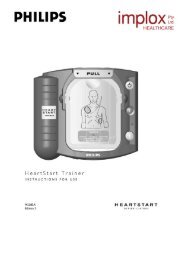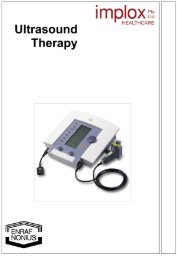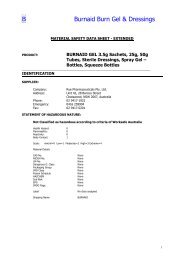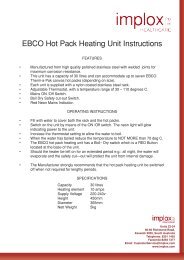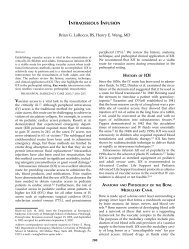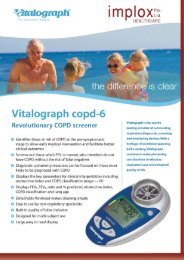Low and medium Frequency Electrotherapy - Implox
Low and medium Frequency Electrotherapy - Implox
Low and medium Frequency Electrotherapy - Implox
Create successful ePaper yourself
Turn your PDF publications into a flip-book with our unique Google optimized e-Paper software.
3.4.2.5 The four-pole method with Isoplanar vector<br />
With the Isoplanar vector the total area between the 4 electrodes is optimal stimulated. The electrode positioning can<br />
be done simple <strong>and</strong> quick. The modulation depth is everywhere 100%.<br />
Isoplanar Interferential can be used for the treatment of problems which are located in a large area <strong>and</strong> which are<br />
very difficult to locate<br />
Isoplanar Interferential is also used as a mild pre-treatment. After this application the treatment is continued with a<br />
focus on a smaller, more local area.<br />
Fig. 23<br />
Isoplanar vector<br />
3.4.3 Criteria for selecting the right parameters<br />
It is not possible to lay down hard <strong>and</strong> fast guidelines with respect to the choice of method. However, there are<br />
certain important points that should be taken into account.<br />
In the two-pole method the modulation depth is always 100%, while the modulation depth in the four-pole method is<br />
only 100% at the diagonals. As stated above, a modulation depth of 100% gives the optimum stimulation effect, <strong>and</strong><br />
is therefore preferred for therapy.<br />
In practice, two electrodes are simpler to position <strong>and</strong> fasten than four. Furthermore, it is also easier to find the<br />
correct localization with two electrodes.<br />
The four-pole method has the advantages of less stress on the skin, combined with increased amplitude at the<br />
application point. However, the stress on the skin is already low with <strong>medium</strong>-frequency currents, due to the greater<br />
depth effect obtained with the higher frequency, <strong>and</strong> the absence of galvanic effects.<br />
The dynamic vector techniques should be used when the region to be treated is relatively large. If localized treatment<br />
is required, the bi-pole method is preferable.<br />
AMF<br />
The AMF can be set as desired according to the type, stage, severity <strong>and</strong> location of the condition to be treated. The<br />
sensations experienced by the patient at the various AMF’s have to be considered.<br />
High frequencies are experienced as ‘more comfortable’, ‘pleasanter’ or ‘lighter’.<br />
A high AMF (80-200 Hz) is advised (5) for acute conditions, great pain <strong>and</strong> hypersensitivity. A high AMF is also<br />
preferable for initial treatment if the patient shows a fear of electricity. At low frequencies the sensation is ‘rougher’,<br />
‘deeper’ or ‘stronger’. Frequencies below 50 Hz can easily lead to (tetanic) contractions.<br />
In less acute cases, i.e. less pain <strong>and</strong> lower sensibility conditions, <strong>and</strong> where muscle contractions are required, a low<br />
AMS is most suitable.<br />
Choice of electrodes<br />
In addition to the usual (flat) electrodes there is also a point electrode. This electrode is specifically intended for the<br />
detection <strong>and</strong> treatment of pain points. It is used in combination with a larger ‘indifferent’ electrode which is placed<br />
well away from the affected area. The point electrode cannot be used with the four-pole method.<br />
Electrode positioning<br />
The electrodes must be positioned in such a way that the patient experiences the stimulation in the affected area.<br />
This should be checked during treatment, <strong>and</strong> the electrodes should be repositioned as necessary. This applies to<br />
both the two-pole <strong>and</strong> the four-pole method.<br />
It is well known that, once a current has been set, the patient will feel the stimulus less clearly after a period of time,<br />
or even completely cease to feel it. This effect is referred to as accommodation, <strong>and</strong> is due to the fact that a fixed<br />
frequency the stimulated sensors will gradually transmit less information to the central nervous system.<br />
Thus, if the stimulus remains unchanged, its effect will become less.<br />
Accommodation must therefore be prevented.<br />
There are three ways of preventing accommodation:<br />
20<br />
1. Increasing the amplitude:<br />
the possibility of strong tetanic contractions must be taken into account. These can be unpleasant for the patient.





